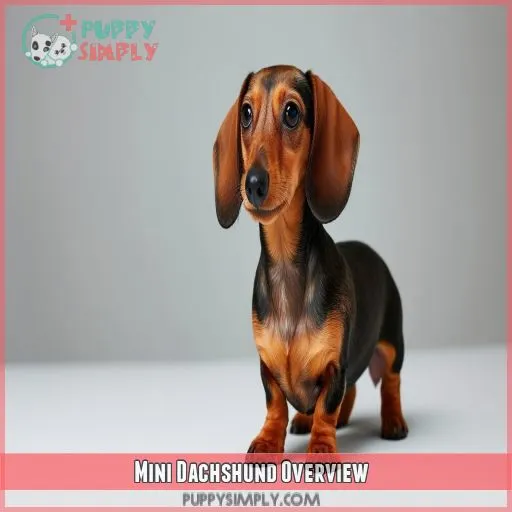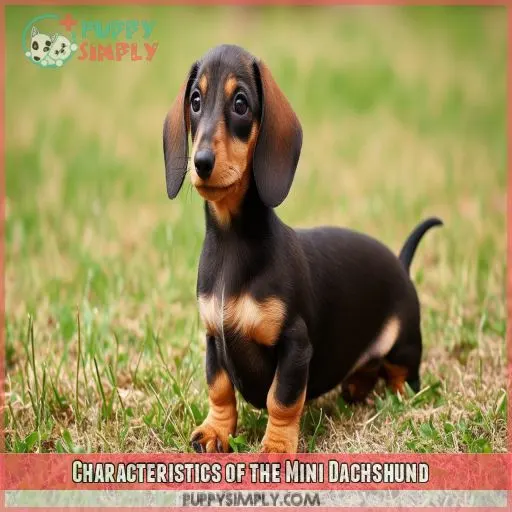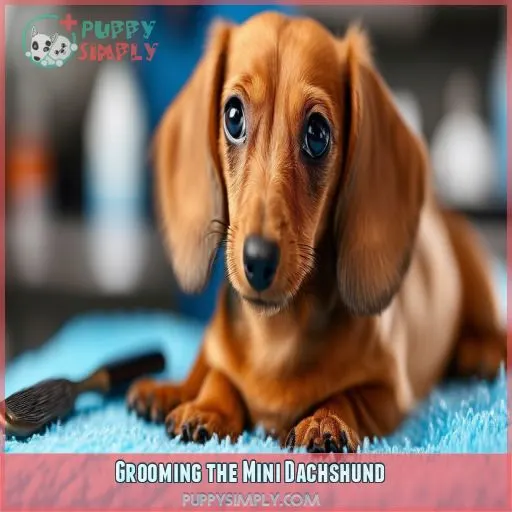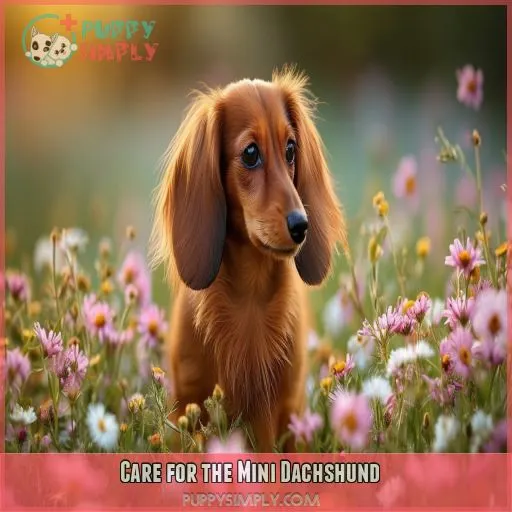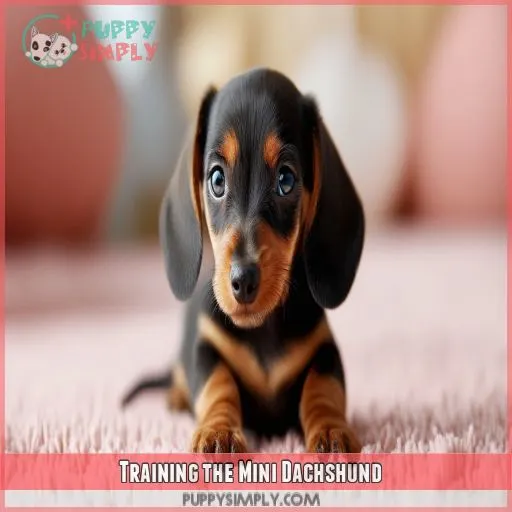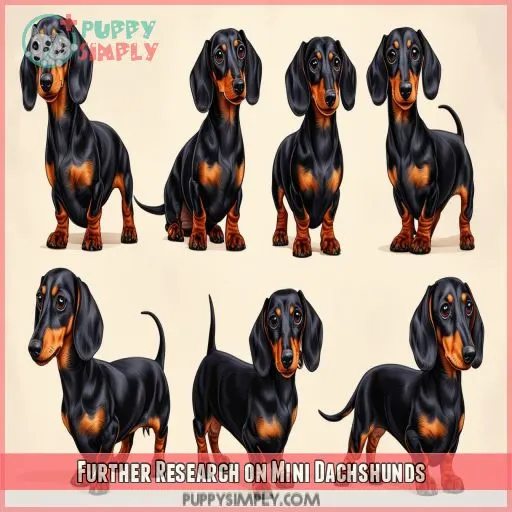This site is supported by our readers. We may earn a commission, at no cost to you, if you purchase through links.
 Prepare to fall head over heels for Mini Dachshunds – the adorably long, low-to-the-ground fur babies with larger-than-life personalities!
Prepare to fall head over heels for Mini Dachshunds – the adorably long, low-to-the-ground fur babies with larger-than-life personalities!
These charismatic companions radiate loyalty, keeping you endlessly entertained with their quirky antics.
From snuggly lap warmers to fearless backyard explorers, mini dachshunds effortlessly toggle between cuddle buddies and adventurers.
Uncover the captivating world of these mighty munchkins – an irresistible blend of cute and comical.
Table Of Contents
- Key Takeaways
- Mini Dachshund Overview
- History of the Mini Dachshund
- Characteristics of the Mini Dachshund
- Grooming the Mini Dachshund
- Care for the Mini Dachshund
- Training the Mini Dachshund
- Adopting or Buying a Mini Dachshund
- Differences Between Standard and Mini Dachshunds
- Further Research on Mini Dachshunds
- Frequently Asked Questions (FAQs)
- What are the common health problems in mini Dachshunds?
- How often should I brush a mini Dachshund’s coat?
- What is the best way to manage a mini Dachshund’s excessive barking?
- How can I prevent my mini Dachshund from chasing other animals?
- What is the recommended diet for a mini Dachshund to prevent obesity?
- Conclusion
Key Takeaways
Key Takeaways for Mini Dachshunds:
- Size and Coat Types: Mini Dachshunds are a smaller version of the standard Dachshund, with three coat types: smooth, wirehaired, and longhaired. They typically weigh 11 pounds or less and stand 5 to 6 inches tall.
- Temperament and Training: Mini Dachshunds are known for their spunky and playful nature, but may also exhibit a stubborn streak during training. They are generally affectionate, friendly, and alert, but may require patience and consistency for effective training.
- Grooming: Smooth-coated Dachshunds need weekly brushing, while longhaired Dachshunds require daily brushing to prevent tangles. Wirehaired Dachshunds need stripping to remove dead hair, and all Dachshunds benefit from regular ear cleaning and nail trimming.
- Exercise and Enrichment: Mini Dachshunds need moderate exercise and mental stimulation, such as daily walks and enrichment activities like food puzzles and hide-and-seek. They also benefit from access to elevated surfaces and routines to establish good behavior.
Mini Dachshund Overview
Mini Dachshund Overview
Mini Dachshunds, also known as Miniature Dachshunds, are a small-sized breed within the hound family. These dogs are adaptable to various living situations, including homes and apartments, and are known for their social, playful, and compatible nature with other pets and humans. They’re low maintenance and generally healthy, with a life expectancy of 12-16 years. Mini Dachshunds are vocal and prone to barking, which is a common trait among Dachshunds.
History
Originating in Germany, Mini Dachshunds were initially bred for hunting badgers and boar. The standard size was initially bred for hunting badgers, while miniature Dachshunds were selectively bred in the late 1800s for rabbit hunting. These dogs have been popular among royalty, with Queen Victoria and Queen Elizabeth II being known to own them. Mini Dachshunds have also gained a nickname, hotdogs, due to their long torso.
Characteristics
Mini Dachshunds come in three coat types: smooth, wirehaired, and longhaired. The smooth coat is short, shiny, and requires regular brushing. The wirehaired coat has a rough, wiry outer coat with a softer undercoat, which requires frequent brushing. The longhaired coat is soft, silky, and needs regular brushing to prevent matting. Mini Dachshunds are playful and mischievous, and they enjoy games and interactive toys. They’ve exceptional senses and alertness, as well as an extraordinary sense of smell. Their innate hunting abilities make them lively and energetic dogs.
Grooming
Mini Dachshunds require regular grooming to maintain their coat’s health and appearance. Smooth-coated Dachshunds need weekly brushing, while longhaired Dachshunds should be brushed several times a week. Wirehaired Dachshunds require stripping to remove dead hair. It’s essential to check their ears for dirt and debris and trim their nails regularly, avoiding cutting them too short.
Care
Mini Dachshunds need daily walks of about 30 minutes for exercise. They benefit from enrichment activities such as food puzzles, lick pads, and hide and seek. To prevent spinal issues, it’s advisable to provide ramps or steps for easy access to elevated surfaces. Establishing routines and boundaries can help ensure good behavior. Spending quality time with your Mini Dachshund can help you understand their needs.
Exercise
Mini Dachshunds require a moderate amount of daily exercise. They enjoy short walks and playtime in the yard or at the park. It’s essential to provide them with a safe and secure environment for exercise and play.
Diet and Nutrition
Mini Dachshunds should be fed a balanced diet appropriate for their age, size, and activity level. It’s essential to avoid overfeeding, as they’re prone to obesity.
Health Issues
Mini Dachshunds are prone to back problems, including disc damage, which can lead to Intervertebral Disc Disease (IVDD). They may also be susceptible to ear infections, obesity, and spinal injuries in the neck or back. Regular veterinary check-ups and preventative care can help manage these health issues.
Training
Mini Dachshunds require patience and consistency in training. Positive reinforcement methods, such as treats and toys, can be effective in teaching them commands. Training can help manage their barking and potty training challenges.
adopting or buying a Mini Dachshund
When adopting or buying a Mini Dachshund, it’s essential to choose a reputable breeder or rescue organization. Ensure that the dog has been properly socialized and is healthy before bringing them home.
Differences Between Standard and Mini Dachshunds
The main difference between Standard and Mini Dachshunds is their size. Standard Dachshunds are larger and are used for hunting badgers, while Mini Dachshunds are smaller and are bred for rabbit hunting. Mini Dachshunds may have a slightly different coat type, but they share many of the same characteristics and health issues.
Further Research on Mini Dachshunds
For more information on Mini Dachshunds, consider visiting the American Kennel Club website, consulting breed-specific rescue organizations, or joining online forums and communities dedicated to Dachshunds.
History of the Mini Dachshund
In the realm of small hounds, the Mini Dachshund stands out as a loyal, cute, and cuddly companion. Understanding the history of this breed is crucial to appreciating its unique characteristics. Here’s a list of four key points about the Mini Dachshund’s history:
- Origin in Germany: The Mini Dachshund originated in Germany, where it was initially bred as a hunting dog for burrowing animals like badgers and rabbits.
- Badger Hunting: The breed was originally used for hunting badgers, a task that required a low-to-the-ground dog with a keen sense of smell and the ability to dig into burrows.
- Miniature Breeding: In the 1800s, a boom in Germany’s rabbit population led to the development of the miniature Dachshund, which was selectively bred for rabbit hunting.
- Popularity Among Royalty: The Mini Dachshund gained popularity among royalty, including Queen Victoria and Queen Elizabeth II, and was nicknamed hotdogs due to its long torso.
These points highlight the Mini Dachshund’s history as a hunting dog and its evolution into a beloved pet. The breed’s adaptability to homes and apartments, social nature, and low maintenance make it a popular choice for those seeking a loyal and friendly companion.
Characteristics of the Mini Dachshund
Mini Dachshunds are known for their small size, which makes them suitable for apartment living. They typically weigh 11 pounds or less and stand at a height of 5 to 6 inches at the shoulder.
These dogs are friendly and upbeat, with a playful nature that requires a moderate amount of exercise. Despite their small size, they have a stubborn streak that can complicate training.
Mini Dachshunds come in three coat varieties: smooth, wirehaired, and longhaired, each with its own grooming requirements. They have a lifespan of 12 to 16 years and are prone to health issues such as back problems, ear infections, and obesity.
Size
Mini Dachshunds are the petite pups of the Dachshund family, standing just 5 to 6 inches tall and weighing 11 pounds or less. Their small size makes them perfect for apartment living, but don’t let their diminutive stature fool you – these pint-sized pooches pack a big personality!
Coat
Mini Dachshunds come in three coat varieties – smooth, wirehaired, and longhaired. Their coats range from short and shiny to thick and wiry. Regardless of type, regular brushing is a must to manage shedding and keep their coats looking their best. Grooming is key for these furry friends!
Temperament
Mini Dachshunds are playful, curious, and loyal companions. They’re known for their big personalities in small packages. While they can be stubborn, positive reinforcement training and early socialization help them become well-behaved family friends. Providing plenty of enrichment activities keeps these clever pups happy and engaged.
Grooming the Mini Dachshund
Grooming your Mini Dachshund is an essential part of maintaining their health and appearance. These small hounds are known for their smooth, wirehaired, or longhaired coats, which require different levels of attention. Here are some grooming tips for each coat type:
- Smooth Coat: This type of coat is short and shiny, requiring regular brushing to remove loose hair and prevent matting. Brush your Mini Dachshund once or twice a week to keep their coat looking neat and healthy.
- Wirehaired Coat: The wiry outer coat and softer undercoat of this type need frequent brushing to prevent matting and keep the coat clean. Use a slicker brush or a rubber curry comb to remove loose fur and maintain the coat’s texture.
- Longhaired Coat: This coat type is soft and silky, requiring regular brushing to prevent matting and keep the hair from tangling. Brush your Mini Dachshund several times a week to keep their long hair looking neat and healthy.
In addition to brushing, there are other grooming tasks to consider:
- Ear Care: Dachshunds have heavy ears and are prone to ear infections. Check their ears regularly for dirt and debris, and clean them with a damp washcloth or moist cotton ball. Avoid using q-tips, as they can push dirt further into the ear canal and cause damage.
- Nail Trimming: Dachshunds have large, thick nails that need regular trimming to prevent splaying. Use a professional dog nail trimmer with a movable built-in guard to avoid over-cutting.
- Dental Care: Dachshunds are prone to dental disease, so it’s essential to brush their teeth regularly with a dog-safe toothbrush and toothpaste.
- Bathing: Bathe your Mini Dachshund every 4-6 weeks to clean their ears, clip their nails, and check their anal glands. Use a dog-specific shampoo and conditioner to keep their coat hydrated and protect against harsh weather conditions.
Care for the Mini Dachshund
As a responsible and loving pet owner, it’s crucial to provide your Mini Dachshund with the right amount of exercise, a balanced diet, and regular health check-ups. Let’s explore these essential aspects of caring for your furry friend.
Exercise
As a Mini Dachshund owner, it’s crucial to provide your furry friend with regular exercise to keep them healthy and happy. Here are some ways to ensure your Mini Dachshund gets enough playtime and exercise:
- Create an exercise routine that includes daily walks, playtime, and interactive toys.
- Socialize your Mini Dachshund with other pets and humans to promote good behavior.
- Enroll them in agility classes to improve their physical fitness and mental stimulation.
- Keep an eye on their weight and provide a balanced diet to prevent obesity.
- Regularly check for signs of Intervertebral Disc Disease (IVDD) and seek veterinary care if necessary.
Diet and Nutrition
Feeding your Mini Dachshund a nutritionally balanced canine diet is crucial for their health.
Obesity is a common issue, so monitor portions and avoid overfeeding.
Some Mini Dachshunds may have allergies, so consider supplements or homemade food.
Picky eating can be a challenge, but fresh water and a varied diet can help.
Skin allergies and patellar luxation may require specialized care.
Always consult with a veterinarian for advice.
Health Issues
As a proud Mini Dachshund owner, you’ll want to keep your furry friend healthy and happy. Here are four key health issues to watch out for:
- Back Injury: Be vigilant about signs of Intervertebral Disc Disease (IVDD).
- Ear Infections: Regularly clean your Dachshund’s ears to prevent infections.
- Obesity: Maintain a balanced diet to prevent obesity, which can lead to health issues.
- Disc Damage: Regular veterinary visits are crucial for detecting disc damage early.
Training the Mini Dachshund
Training your Mini Dachshund can be an enjoyable and rewarding experience. With their playful temperament, they’re eager to learn and respond well to positive reinforcement techniques. Here are some steps to help you train your Mini Dachshund:
- Identify the behavior you want to encourage: Start with basic commands like sit, stay, and come. Gradually introduce more complex behaviors like fetching a ball or walking on a leash without pulling.
- Choose the right reward: Use treats, toys, or verbal praise to motivate your Mini Dachshund. Rewards should be given immediately after the desired behavior to reinforce the connection between the action and the reward.
- Use positive reinforcement: Praise your Mini Dachshund for good behavior and reward them with treats or toys to encourage them to repeat the desired behavior. Consistency is key in positive reinforcement training.
- Socialization tactics: Introduce your Mini Dachshund to new environments, people, and other dogs to help them become comfortable and confident in various situations. This can be done through car rides, visits to the park, or playdates with other dogs.
- Crate training: Use a crate to provide a safe and secure space for your Mini Dachshund. This can help with potty training and can also serve as a place for them to retreat when they feel overwhelmed.
- Play and enrichment activities: Engage your Mini Dachshund in interactive toys and games to keep them mentally stimulated and physically active. This can help reduce boredom and destructive behaviors.
- Clear routines: Establish a routine for feeding, exercise, and playtime to help your Mini Dachshund understand what’s expected of them. This can also help with potty training and other behavioral issues.
- Safety precautions: Be aware of potential health issues, such as back problems, and take steps to prevent injury. For example, provide ramps or steps for easy access to elevated surfaces to reduce spinal issues.
Adopting or Buying a Mini Dachshund
Looking to adopt or buy a Mini Dachshund? Here’s a step-by-step guide to help you navigate through the process:
- Adoption Process: Start by researching local rescue groups and animal shelters that specialize in Mini Dachshunds. Many organizations have waiting lists for potential adopters, so be prepared for a bit of a wait.
- Financial Implications: Consider the financial implications of owning a Mini Dachshund. Monthly costs can include food, veterinary care, grooming, and other expenses. It’s advisable to budget for pet insurance, as Dachshunds are prone to certain health issues.
- Home Preparation: Before bringing your new companion home, make sure your living space is Dachshund-friendly. This includes removing potential hazards and creating a safe environment for your pet.
- Puppy Training: Mini Dachshunds are intelligent and require training. Begin training as soon as you bring your pet home, focusing on basic obedience and house training. If you’re adopting, the rescue group or shelter may offer training resources to help you get started.
- Senior Care: If you’re adopting an older Mini Dachshund, be prepared for any potential health issues that may arise. Senior care may involve additional veterinary visits and adjustments to your pet’s diet and exercise routine.
Differences Between Standard and Mini Dachshunds
When it comes to choosing between a Mini and a Standard Dachshund, there are several differences to consider. The Mini Dachshund, weighing in at 11 pounds or less, is smaller in size compared to the Standard Dachshund. This size difference can impact their temperament, activity levels, and health concerns. Mini Dachshunds are known for their playful and mischievous nature, while Standards are typically more independent and strong-willed. In terms of activity, Mini Dachshunds may require less exercise than their Standard counterparts, but they still need daily walks and playtime to stay happy and healthy.
One of the most significant differences between the two breeds is the risk of back injury. Both Mini and Standard Dachshunds are prone to Intervertebral Disc Disease, but the Mini’s smaller size may make them more susceptible to spinal issues. It’s crucial to provide ramps or steps for easy access to elevated surfaces and to avoid overexertion.
In conclusion, when deciding between a Mini and a Standard Dachshund, consider their size, temperament, activity levels, and health concerns. Both breeds have unique qualities that make them wonderful companions, but understanding these differences can help you choose the right one for your lifestyle and preferences.
Further Research on Mini Dachshunds
Diving deeper into the world of Mini Dachshunds, you’re bound to get hooked on their charming quirks. But before you dash off to find your pint-sized pal, a bit of homework can save you a world of hassle. Start by sniffing around Dachshund Breeders who prioritize health over cuteness. These pups may have a nose for adventure, but they’re not immune to health issues.
Next, consider a Dachshund Rescue. These organizations are treasure troves of loveable, sniff-happy hounds itching for a second chance. Joining Dachshund Clubs can also be a hoot, offering a community of fellow Dachshund devotees and a wealth of knowledge on everything from mental stimulation to the best doggy puzzles that’ll keep your mini’s mind as sharp as their sense of smell. Remember, a well-researched decision is a step towards a happy, healthy Mini Dachshund life.
Frequently Asked Questions (FAQs)
What are the common health problems in mini Dachshunds?
You’ll want to watch for back issues, obesity, and eye/ear problems with your mini dachshund. But hey, regular checkups and a healthy lifestyle can help prevent many issues!
How often should I brush a mini Dachshund’s coat?
You’ll need to brush your mini dachshund weekly if they’ve a smooth coat, or several times a week for a longhaired coat. Regular brushing keeps their coat healthy and prevents matting.
What is the best way to manage a mini Dachshund’s excessive barking?
Excessive barking? You bet your wiener dog won’t pipe down! Train with treats, playtime after quiet, and interrupt barks consistently. It’s a process, but your pint-sized pup will learn.
How can I prevent my mini Dachshund from chasing other animals?
You’ll need to start training early with positive reinforcement. Use a firm leave it command when your pup gets distracted, and reward good behavior. With consistency and patience, you can curb that hunting instinct.
What is the recommended diet for a mini Dachshund to prevent obesity?
Picture a dachshund rolypoly – it’s adorable but unhealthy! Prevent obesity by feeding your mini doxie a high-protein, low-fat diet with portion control.
Conclusion
If mini dachshunds are your cup of tea, don’t hesitate to dive into everything you could want to know about these loyal, cute and cuddly companions. With their unique personalities and endless entertainment, these mighty munchkins will undoubtedly steal your heart and make you fall head over heels for their charms.

